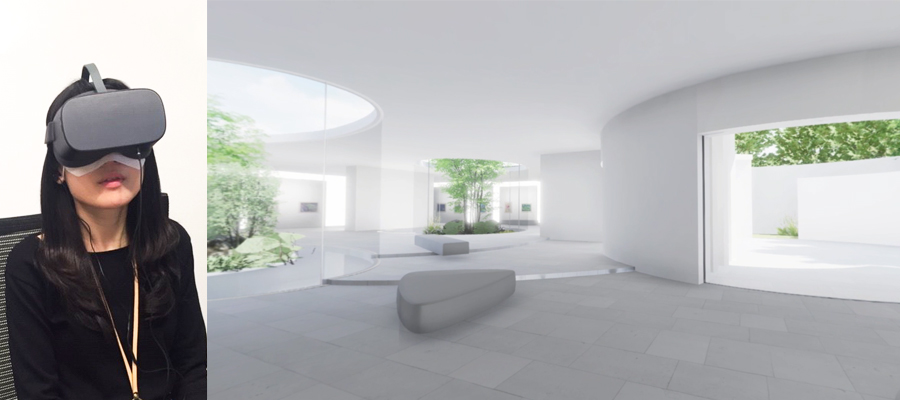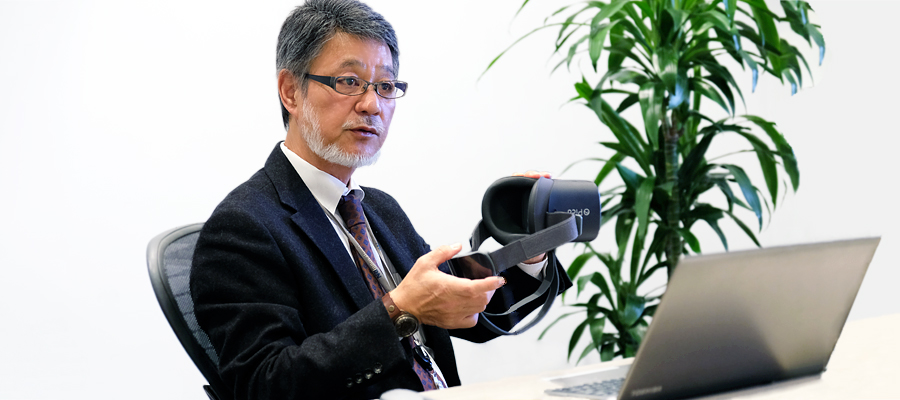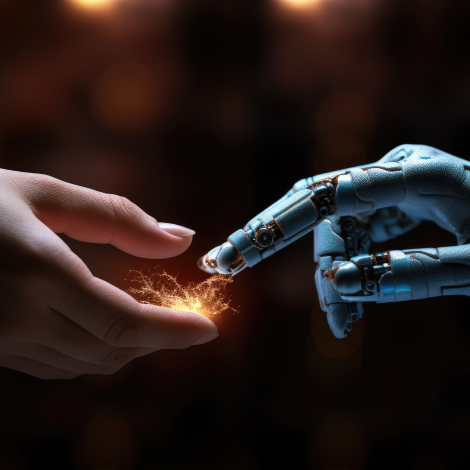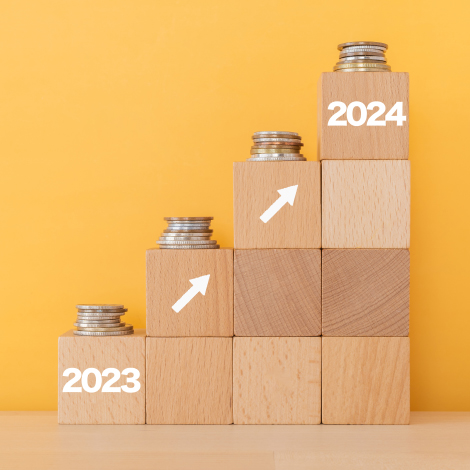Stress Reduction through the Utilization of Virtual Reality (VR)—Enhanced Relaxation and Energy Brought on by Virtual Space Experience
Feb. 06, 2020
In recent years, the heightening stress felt by working people has become a societal problem. Given these circumstances, in 2015, stress check systems became mandatory for businesses. As a result, businesses have been making various efforts to encourage employees to relax more. NRI has been conducting research on stress reduction through visual and audio sensations created through virtual reality (VR). We asked Toru Hamabe, who has been engaged in VR technology research for many years, about the utilization of VR and relaxation.
Experiencing virtual relaxation space
A little while after you have put on VR goggles, a white building will appear before your eyes. After you enter the building, you will be in a spacious semi-circular room. The curved white wall is decorated with a number of vivid western paintings. At some point, comforting music will start to play. When you look at left end of the room, before you even realize it, you become aware of a drawing. After looking at it carefully, you shift your gaze to another piece of work displayed next to it. There is no one else. You can appreciate the work slowly, at your own pace. As you look at the drawing, gradually, you start to concentrate…
This is what is experienced when viewing the “NRI Virtual Art Museum”, which was created by VR. Rather than “looking,” the sensation is that of being immersed in the middle of a realistic dream.
NRI’s Toru Hamabe is the designer of this space. He is an expert who has been researching VR technology and virtual environments representations for more than 30 years. Since the spring of 2019, he has been researching the utilization of VR for the purpose of encouraging relaxation among working people.

Graphic image that can be experienced in VR, and a person experiencing VR
VR that can be used by anyone at any time
Hamabe explains as follows why he presented such a space in VR.
“Recently, excessive stress on working people at companies has become a problem, and many companies are continuing with efforts to reduce the stress level of their employees. At NRI as well, seminars to reduce stress are being held, and massage rooms, power nap rooms, and exercise classes etc. are being provided, However, unfortunately, not all employees are able to use them regularly without reserve. In addition, it has not yet been proven to what degree such efforts have resulted in stress reduction.
So, we came up with the idea of utilizing VR. Because of advancements in AR and VR-related technology, the practical application of 5G, and other factors, it has become possible to present art and natural environments as well as other realistic content smoothly. Further, it can easily be used by anyone, at any place, just by putting on VR goggles (head mount display = HMD). At the same time, we thought that we would measure and test how experiencing such a space would affect relaxation.
Natural scenery that has a highly relaxing effect
In addition to the “(i) NRI Virtual Art Museum” mentioned in the beginning of this article, Hamabe also created three other virtual spaces in VR. One is “(ii) Natural Scenery,” where you can walk in a verdant forest. Further, in “(iii) Yokohama Museum of Art,” which replicated the interior of an actual museum, you can experience an exhibition space where large-scale murals by Yusuke Asai (artist) are displayed (all of the displayed works are part of the Yokohama Museum of Art Collection). Finally, in the VR of “(iv) Otsuka Museum of Art”, which is located in Naruto-shi, Tokushima Prefecture, you can appreciate religious art and impressionist paintings that are displayed in a chapel. NRI is conducting research to determine how stimuli from these four videos and the sounds in them can influence one’s peace of mind and revitalization.
In an experiment that was conducted on approximately 20 NRI male and female employees in their 20s through their 40s, the subjects randomly viewed a single video, once a week over the course of five weeks. During such times, using equipment such as automatic nerve measuring instruments, changes to their psychological state before and after the viewings were measured to see what kind of effect each of the virtual spaces had on relaxation.
“A major premise is that the ideal state of the automatic nervous system is one where a balance between the ‘degree of activeness (activity)’ and the ‘degree of relaxation (stability)’ is being maintained.”
The results of the experiment were as follows:
In the “(i) NRI Virtual Art Museum”, the subjects were able to concentrate and their energy levels were increased, even while they were relaxed.”
In “(ii) Natural Scenery,” the subjects were relaxed, but internal concentration brought about lethargy, and their energy decreased.
In “(iii) Yokohama Museum of Art,” “the subjects were able to concentrate and their energy increased, but they started to feel tense and their level of relaxation decreased.”
In “(iv) Otsuka Museum of Art,” “the subjects were able to concentrate and were relaxed, and their energy increased.”
Regarding these results, Hamabe states: “we see that a natural environment has a high relaxing effect.” As for the decrease in relaxation in (iii), he surmises that “It’s probably because the subjects spent more mental energy to appreciate the art.”
In the future, sensitivities may be refined at virtual art museums
Hamabe was originally involved in the mental care of cancer patients utilizing VR technology.
“I realized that merely entering the VR world and having a conversation strengthened immunity. As an extension of such research, I wondered if VR could be used for relaxation.” As for the reasons behind his strong focus on VR utilization, Hamabe states the following.
“When people only hear music or see a video, each person will imagine a different image. But your senses become more vivid when you are experiencing a deep space created by images with a highly relaxing effect together with music in closed conditions.”
Once the research reaches a certain stage and the effects are proven, the plan is for all NRI employees to be able to use the “VR Relaxation System”. The aim is to install the system at NRI’s locations and commence use in the second half of 2020.
“In this research, we are hoping not only to increase relaxation, but also to refine one’s senses through art, enhance awareness, and heighten creativity. For that reason, we displayed videos that show spaces inside art museums. Through continuing our research, we would like to utilize VR in that field as well.”
Popular art museums and exhibitions are always crowded, making it difficult to appreciate them without feeling rushed. In the future, we may be able to expect art museum viewing services using VR, allowing one to enjoy the museums at any time at their own pace.








